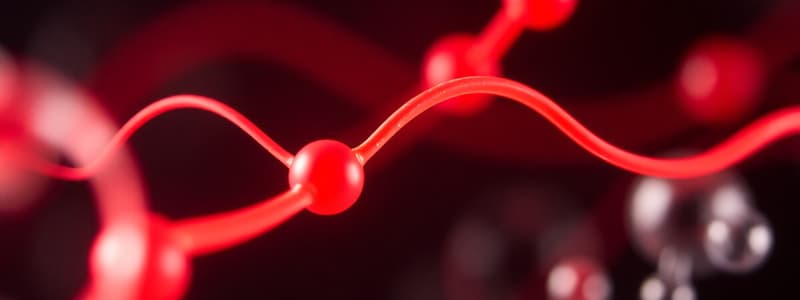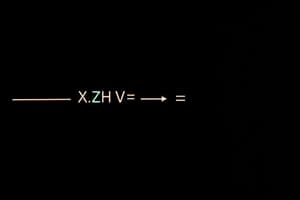Podcast
Questions and Answers
What happens to the reaction velocity as substrate concentration increases?
What happens to the reaction velocity as substrate concentration increases?
- It remains constant regardless of substrate concentration.
- It decreases steadily as more substrate is added.
- It increases then decreases due to enzyme saturation.
- It increases until a maximal velocity is reached. (correct)
How does temperature generally affect enzyme reaction velocity?
How does temperature generally affect enzyme reaction velocity?
- The velocity decreases continuously with increasing temperature.
- The velocity increases indefinitely with temperature.
- The velocity increases until a peak is reached, then it decreases. (correct)
- The velocity is not affected by temperature changes.
What characterizes the enzyme kinetics curve for most enzymes?
What characterizes the enzyme kinetics curve for most enzymes?
- It is hyperbolic in shape. (correct)
- It is sigmoidal in shape.
- It is linear across all substrate concentrations.
- It shows drastic fluctuations at certain concentrations.
What is the effect of extreme temperatures on human enzymes?
What is the effect of extreme temperatures on human enzymes?
What distinguishes allosteric enzymes from those that follow Michaelis–Menten kinetics?
What distinguishes allosteric enzymes from those that follow Michaelis–Menten kinetics?
How can elevated substrate concentration affect enzyme activity?
How can elevated substrate concentration affect enzyme activity?
What is the optimal temperature range for most human enzymes?
What is the optimal temperature range for most human enzymes?
What effect does substrate saturation have on enzyme activity?
What effect does substrate saturation have on enzyme activity?
What term describes the protein component of an enzyme along with its nonprotein components?
What term describes the protein component of an enzyme along with its nonprotein components?
Which of the following is an example of a cofactor?
Which of the following is an example of a cofactor?
What is the energy barrier that must be overcome for a reaction to proceed called?
What is the energy barrier that must be overcome for a reaction to proceed called?
Which statement best describes a prosthetic group?
Which statement best describes a prosthetic group?
What happens to coenzymes during the enzymatic reaction?
What happens to coenzymes during the enzymatic reaction?
Why is compartmentalization of enzymes within cells important?
Why is compartmentalization of enzymes within cells important?
Which perspective describes how the active site facilitates catalysis?
Which perspective describes how the active site facilitates catalysis?
What type of nonprotein component is derived from vitamins?
What type of nonprotein component is derived from vitamins?
What role does the active site play in enzyme catalysis?
What role does the active site play in enzyme catalysis?
Which type of catalysis involves amino acid residues providing or accepting protons?
Which type of catalysis involves amino acid residues providing or accepting protons?
How can the transition state be visualized in an enzyme-catalyzed reaction?
How can the transition state be visualized in an enzyme-catalyzed reaction?
Which of the following statements about enzymes is correct?
Which of the following statements about enzymes is correct?
Which type of catalysis is specifically utilized by chymotrypsin?
Which type of catalysis is specifically utilized by chymotrypsin?
What affects the probability of the transition state being formed during a reaction?
What affects the probability of the transition state being formed during a reaction?
Which factor is not typically mentioned as affecting enzyme activity?
Which factor is not typically mentioned as affecting enzyme activity?
What happens to the energy of the substrate when it binds to the enzyme?
What happens to the energy of the substrate when it binds to the enzyme?
Flashcards are hidden until you start studying
Study Notes
Enzyme Velocity
- The rate or velocity (v) of an enzyme-catalyzed reaction is the number of substrate molecules converted into product per unit time, typically measured in μmol of product formed per second.
- Reaction velocity increases with substrate concentration until a maximal velocity (Vmax) is reached, indicating saturation of all available binding sites on the enzyme molecules.
- Most enzymes follow Michaelis–Menten kinetics, resulting in a hyperbolic plot of initial reaction velocity (vo) against substrate concentration.
- Allosteric enzymes, however, do not follow Michaelis–Menten kinetics, exhibiting a sigmoidal curve instead.
Temperature and Enzyme Velocity
- Reaction velocity increases with temperature until a peak velocity is reached, due to increased substrate molecule energy overcoming the energy barrier.
- Further temperature elevation causes a decrease in reaction velocity due to temperature-induced enzyme denaturation.
- Human enzymes have an optimum temperature between 35° and 40°C, while thermophilic bacteria found in hot springs have optimum temperatures of 70°C.
Enzyme Components and Structure
- Some enzymes require nonprotein components for activity, including metal ions (cofactors) and small organic molecules (coenzymes).
- The complete enzyme with its nonprotein component is called a holoenzyme, while the enzyme without its nonprotein moiety is termed an apoenzyme and is inactive.
- Coenzymes can be permanently (prosthetic groups) or transiently associated with an enzyme.
- Coenzymes are often derived from vitamins, like NAD+ containing niacin, and FAD containing riboflavin.
Enzyme Regulation
- Enzyme activity can be increased or decreased to respond to cellular needs.
Enzyme Location
- Most enzymes function within cells, confined by plasma membranes.
- Many enzymes are localized within specific organelles, facilitating compartmentalization and organized metabolic pathways.
Enzyme Action: Energy Changes
- Chemical reactions have an energy barrier separating reactants and products, called the activation energy (Ea).
- Enzymes lower the activation energy by stabilizing the transition state, accelerating the reaction.
Enzyme Action: Active Site Catalysis
- The active site of an enzyme provides catalytic groups that enhance transition state formation.
- Catalytic groups can participate in general acid–base catalysis, providing or accepting protons.
- Covalent catalysis can also occur, forming a transient covalent ES complex.
- Chymotrypsin, an enzyme of protein digestion, exemplifies general base, general acid, and covalent catalysis, involving histidine and serine residues at its active site.
Enzyme Action: Transition State Visualization
- The conversion of substrate to product can be visualized as removing a "sweater" (chemical group) from an "infant" (substrate).
- Enzymes act as "parents," guiding the substrate into a transition state conformation that facilitates product formation.
Studying That Suits You
Use AI to generate personalized quizzes and flashcards to suit your learning preferences.




